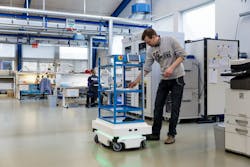Chances are you either have an iRobot Roomba at home or are at least familiar with its operation. These robotic floor cleaners—using a combination of sensors and microprocessors—independently navigate around your house to clean your floors, virtually eliminating the need for you to haul out the vacuum cleaner (unless you have stairs, of course). By applying a similar design approach to automated guided vehicles, suppliers of mobile, logistics-oriented robots are changing the AGV market.
If you're wondering about the potential for this market, the International Federation of Robotics predicts that the mobile robot industry is expected to achieve total sales of 14,500 units and revenue of $20 billion over the next three years.
One of the more prominent products in this emerging market is the MiR100 from Mobile Industrial Robots (MiR). Whereas AGVs require tracking systems (either embedded in the concrete floor of the facility or adhered to it) to guide them, the MiR100 uses built-in scanning sensors, a 3D camera and ultrasound to navigate its way around a facility. Though MiR (based in Denmark and founded in 2013) is new to the U.S. market, having just opened its first U.S. office in April, the company currently supplies its MiR100 to several global manufacturers, such as Leoni, Flextronics and Continental.
MiR100 has a carrying capacity of 220 pounds and can tow approximately 660 pounds. It also has custom modules that can be added to address various logistics/hauling requirements. The battery enables up to 15 hours of operation or 20 km of travel.
Like its collaborative robot counterparts, the MiR100 eliminates the teach pendant approach to robot programming. Instead it uses a more intuitive interface that can be accessed on an iOS or Android device or PC. According to MiR, the robot can either self identify its surroundings via the onboard sensors and cameras, or have 3D drawings of the building layout imported. The sensors and cameras used by MiR reportedly enable “safe, collaborative operation” around people, as the robot will stop and automatically route itself around people or objects. It complies with the EN 1525 safety standard for driverless trucks.
Further highlighting the connection between the mobile and collaborative robot industries, Thomas Visti, CEO of MiR, previously served as chief commercial officer at Universal Robots from 2009-2014 before joining MiR.
At a price point of just under $30,000, MiR claims that most companies achieve a return on investment in MiR100 within one year.
The video below shows the MiR100 in action.

